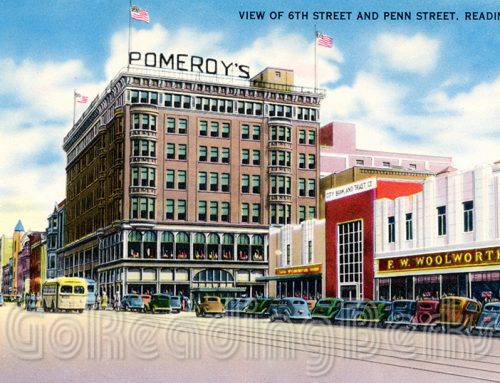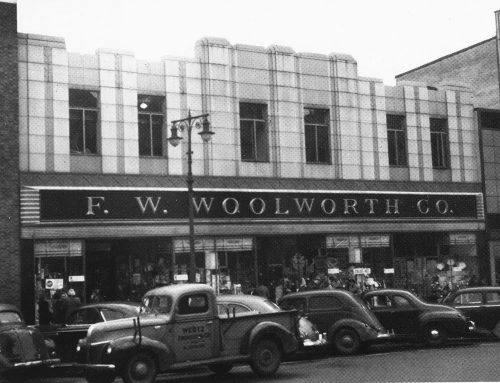McCrory Stores or J.G. McCrory’s was a chain of five and dime stores in the United States based in York, Pennsylvania.
Below: South Side, 500 block of Penn Street, 1960s.

Below: South Side, 500 block of Penn Street, left to right: Sun Ray Drug, 522; Triplex Shoes, 520; Lobel’s, 518; McCrary’s, 514; W. T. Grant Co., 508.

John Graham McCrorey opened his first store in Scottdale, Pennsylvania, in 1882. By 1885, the chain had five stores in Pennsylvania. McCrory was known for his thrifty nature, so much so that he legally dropped the e from his last name so he would not have to pay for extra letters on his store signs.
In 1897, John G. McCrory and Sebastian S. Kresge together opened the first Kresge store in Memphis, offering a variety of 5-to-10-cent merchandise from stationery to combs to sewing supplies. The S.S. Kresge chain later became Kmart.
Along with Frank W. Woolworth, the two men pioneered the concept of the American variety store. During the first half of the 20th century, a Woolworth, Kresge or McCrory “5 and 10” eventually sprouted in almost every city and town in the United States, ultimately spreading to Europe, Canada and Australia.
The first McCrory 5 and 10 cent store in Reading opened on March 15, 1913 on Penn Square at 510 Penn Street. Another store would later open at 3274 Fifth Street Highway, Muhlenberg Township. The first store had forty-five departments containing in all over 10,000 different items of merchandise consisting of laces and embroideries from France, Switzerland, Germany, England, Scotland and Ireland; handkerchiefs, towels, and table goods of pure linen from the famous looms of old Ireland, curtains from Nottingham, England; fine china from Bavaria and Austria, countries famous for centuries as criterions in the china-making industry; novelties all the way from the far East; toys from the shops of the old German artisans of the Black Forest; pine and notions of all kinds from the various manufacturing centers of Germany. All these were but a few examples of the extent of the McCrory stores purchasing power. Prices ranged from 10 cents each all the way down to 50 items for 5 cents. Consumers marveled at the uniformly high grade quality of the items.
Below: South Side, 500 block of Penn Street.

Below: Penn Square Pedestrian Mall, 1970s.

McCrory died in 1923 having built McCrory Stores Corporation into a success. However, in 1933 the company declared bankruptcy and was dissolved, but it was eventually re-established as McCrory Stores and resumed operations.
At its height, McCrory’s operated 1,300 stores under its own name and as TG&Y, McLellan (merged in 1958), H.L. Green, Silvers, G.C. Murphy, J.J. Newberry and Otasco, which it had acquired through the years. McCrory’s parent Rapid-American also owned Lerner Stores and National Shirt (acquired by McCrory’s in 1960).
Meshulam Riklis purchased McCrory’s in 1960, and moved its headquarters to Springettsbury Township, York County, Pennsylvania, in 1963. At the time it was the fourth largest retailer in the United States. Riklis controlled McCrory’s through the Rapid-American holding company, which was managed by Samuel Neaman. Riklis’ famed sleight of hand, shifting assets between notable brand name successful companies and holding companies is best exemplified by his handling of McCrory Stores, driving the brand name into bankruptcy while keeping the assets. Among the retailers controlled by McCrory’s at the time were Best & Co., Lerner Shops, and S. Klein.
In 1986 it purchased the 76 remaining Kresge and Jupiter stores from Kmart, reuniting the companies. It was at this time controlled by E-II Holdings, Inc., which also owned Elmore, Britts, and Kittinger and Bargain Time. E-II Holdings was a group of jilted Riklis investors, seizing old Riklis properties trying to recoup their losses.
In 1989, 1,300 stores were operated by the McCrory Company. However, as the decade turned, its fortunes decreased, and by 1992 it filed for bankruptcy.
In 1993 the McCrory’s store on Penn Square changed its name to 99 Cents and More. The McCrory’s at 3274 Fifth Street Highway, Muhlenberg Township, remained a McCrory’s.
Several rounds of store closures followed, with one of the biggest coming in 1997 when McCrory’s shuttered 300 of its last 460 stores.
In 1997 the McCrory’s store on Penn Square was permanently closed for business.
The company converted some stores to their Dollar Zone format of dollar stores, but these closed in early 2002. In December 2001, McCrory Stores announced the remaining McCrory’s, TG&Y, G. C. Murphy and J.J. Newberry stores it was operating would begin liquidating and in February 2002 the company ceased operation.
In 1997 the old McCrory’s store on Penn Square became a Valu-Plus variety store. Today the building is occupied by an EZ Bargain Discount Store.
Below: South Side, 500 block of Penn Street, 2016.







Leave A Comment